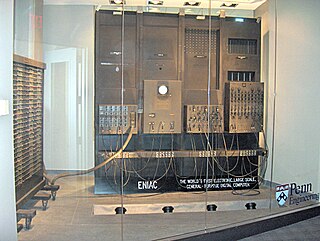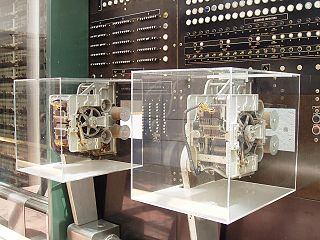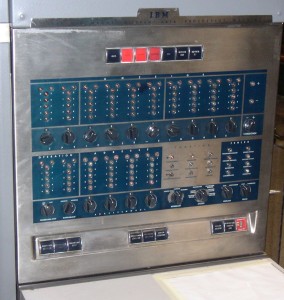
In a computer's central processing unit (CPU), the accumulator is a register in which intermediate arithmetic logic unit results are stored.

The history of computing hardware covers the developments from early simple devices to aid calculation to modern day computers.

A punched card is a piece of stiff paper that holds digital data represented by the presence or absence of holes in predefined positions. Punched cards were once common in data processing applications or to directly control automated machinery.

ENIAC was the first programmable, electronic, general-purpose digital computer, completed in 1945. There were other computers that had combinations of these features, but the ENIAC had all of them in one package. It was Turing-complete and able to solve "a large class of numerical problems" through reprogramming.

The IBM 604 Electronic Calculating Punch was the world's first mass-produced electronic calculator along with its predecessor the IBM 603. It was an electronic unit record machine that could perform multiple calculations, including division. It was invented and developed by Ralph Palmer, Jerrier Haddad and Byron Phelps. It was introduced by IBM in 1948.

UNIVAC was a line of electronic digital stored-program computers starting with the products of the Eckert–Mauchly Computer Corporation. Later the name was applied to a division of the Remington Rand company and successor organizations.

The Harvard Mark I, or IBM Automatic Sequence Controlled Calculator (ASCC), was a general-purpose electromechanical computer used in the war effort during the last part of World War II.

A mechanical calculator, or calculating machine, is a mechanical device used to perform the basic operations of arithmetic automatically, or (historically) a simulation such as an analog computer or a slide rule. Most mechanical calculators were comparable in size to small desktop computers and have been rendered obsolete by the advent of the electronic calculator and the digital computer.
Wallace John Eckert was an American astronomer, who directed the Thomas J. Watson Astronomical Computing Bureau at Columbia University which evolved into the research division of IBM.

The IBM Card-Programmed Electronic Calculator or CPC was announced by IBM in May 1949. Later that year an improved machine, the CPC-II, was also announced.

Starting at the end of the nineteenth century, well before the advent of electronic computers, data processing was performed using electromechanical machines collectively referred to as unit record equipment, electric accounting machines (EAM) or tabulating machines. Unit record machines came to be as ubiquitous in industry and government in the first two-thirds of the twentieth century as computers became in the last third. They allowed large volume, sophisticated data-processing tasks to be accomplished before electronic computers were invented and while they were still in their infancy. This data processing was accomplished by processing punched cards through various unit record machines in a carefully choreographed progression. This progression, or flow, from machine to machine was often planned and documented with detailed flowcharts that used standardized symbols for documents and the various machine functions. All but the earliest machines had high-speed mechanical feeders to process cards at rates from around 100 to 2,000 per minute, sensing punched holes with mechanical, electrical, or, later, optical sensors. The operation of many machines was directed by the use of a removable plugboard, control panel, or connection box. Initially all machines were manual or electromechanical. The first use of an electronic component was in 1937 when a photocell was used in a Social Security bill-feed machine. Electronic components were used on other machines beginning in the late 1940s.

The tabulating machine was an electromechanical machine designed to assist in summarizing information stored on punched cards. Invented by Herman Hollerith, the machine was developed to help process data for the 1890 U.S. Census. Later models were widely used for business applications such as accounting and inventory control. It spawned a class of machines, known as unit record equipment, and the data processing industry.

The IBM Selective Sequence Electronic Calculator (SSEC) was an electromechanical computer built by IBM. Its design was started in late 1944 and it operated from January 1948 to August 1952. It had many of the features of a stored-program computer, and was the first operational machine able to treat its instructions as data, but it was not fully electronic. Although the SSEC proved useful for several high-profile applications, it soon became obsolete. As the last large electromechanical computer ever built, its greatest success was the publicity it provided for IBM.
Herbert Reuben John Grosch was an early computer scientist, perhaps best known for Grosch's law, which he formulated in 1950. Grosch's Law is an aphorism that states "economy is as the square root of the speed."

The IBM 602 Calculating Punch, introduced in 1946, was an electromechanical calculator capable of addition, subtraction, multiplication, and division. The 602 was IBM's first machine that did division. Like other IBM calculators, it was programmed using a control panel. Input data was read from a punched card, the results could be punched in the same card or a trailing card.
International Business Machines (IBM) is a multinational computer technology and IT consulting corporation headquartered in Armonk, New York, United States. IBM originated from the unification of several companies that worked to automate routine business transactions, including the first companies to build punched card based data tabulating machines and to build time clocks. In 1911, these companies were amalgamated into the Computing-Tabulating-Recording Company (CTR).

The IBM 603 Electronic Multiplier was the first mass-produced commercial electronic calculating device; it used full-size vacuum tubes to perform multiplication and addition. The IBM 603 was adapted as the arithmetic unit in the IBM Selective Sequence Electronic Calculator. It was designed by James W. Bryce, and included circuits patented by A. Halsey Dickenson in 1937. The IBM 603 was developed in Endicott, New York, and announced on September 27, 1946.

Cuthbert Corwin Hurd was an American computer scientist and entrepreneur, who was instrumental in helping the International Business Machines Corporation develop its first general-purpose computers.

The IBM Naval Ordnance Research Calculator (NORC) was a one-of-a-kind first-generation computer built by IBM for the United States Navy's Bureau of Ordnance. It went into service in December 1954 and was likely the most powerful computer at the time. The Naval Ordnance Research Calculator (NORC), was built at the Watson Scientific Computing Laboratory under the direction of Wallace Eckert.
Eleanor Krawitz Kolchin was an American mathematician, computer programmer, author, and teacher. She worked at Watson Scientific Computing Laboratory at Columbia University to calculate the orbit of planets, phases of the moon, and trajectories of asteroids using IBM tabulating machines. Her calculations were used in the Apollo program.

















